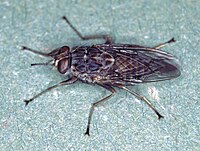
Photo from wikipedia
Trypanosomosis is one of the most economically challenging diseases affecting mammals, and it is a serious haemoprotozoan disease caused by different species of unicellular eukaryotic parasite of the genus trypanosome.… Click to show full abstract
Trypanosomosis is one of the most economically challenging diseases affecting mammals, and it is a serious haemoprotozoan disease caused by different species of unicellular eukaryotic parasite of the genus trypanosome. The study was conducted to access the prevalence of bovine trypanosomosis, its associated risk factors, and vector density on cattle reared in three selected districts, namely, Chewaka, Dabo Hana, and Meko districts. Blood was collected from a total of 1046 cattle of age groups extending from 1 to 6 years. The buffy coat technique was used to check the presence of parasites from sampled blood, and the trypanosome species were identified using Giemsa-stained thin blood films. The packed cell volume of sampled blood was determined using the haematocrit. A total of 160 traps were deployed to study the entomological survey. Generally, 3.44% of the studied animal was infected with trypanosomosis, and T. vivax was the dominant species of trypanosomosis in the study areas. Significant differences (P < 0.05) were observed due to associated factor viz. body condition and anaemic status of the animal; however, insignificant differences were also recorded between different districts, age group, and sex. The mean PCV value of parasitaemic and aparasitaemic animals was 22.22 ± 0.92 and 26.18 ± 0.16, respectively, and significant difference was P < 0.05. An overall of 1.82 flies per trap per day was recorded from the study areas, and among the total caught vectors, 81.4% of it was G. tachinoides and the rest was G. morsitans. Therefore, the veterinarians have to continue providing the appropriate medication/treatment for the infected animals per appropriate recommendation, and Bedele NTTICC has to take more measures to control the density and distribution of tsetse flies in Dabo Hana district than the others due to high flies per trap per day observed in Dabo Hana district.
Journal Title: Veterinary Medicine International
Year Published: 2020
Link to full text (if available)
Share on Social Media: Sign Up to like & get
recommendations!